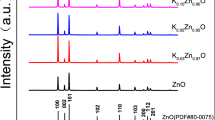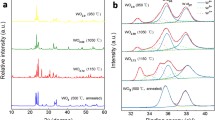Abstract
Zn1−xNixO (X = 0%, 1%, 3%, 5%, 10%) nanowires were synthesized by the hydrothermal method, and the prepared materials were characterized and analyzed by XRD, SEM and XPS. Then, the materials were positioned on the pre-designed Ti/Au interdigital electrode to fabricate humidity sensors by the dielectrophoresis method. The humidity sensitive characteristics of the sensors were studied by combining complex impedance spectroscopy and theory of multilayer adsorption. The results show that the surface oxygen vacancies concentration can be regulated by Ni doping process. Under the combined action of Ni ions and oxygen vacancies, the performance of humidity sensors has been improved significantly. Especially, 5% Ni doped ZnO humidity sensor shows a high capacitance sensitivity, which is varied by more than four orders of magnitude with increasing the relative humidity from 11 to 95%, respectively. Moreover, the response time and recovery time are reduced to 27 s and 2 s, which is much better than undoped ZnO humidity sensor. The results indicate that the doping of Ni elements play an important role in the sensing property improvement of ZnO humidity sensor.
















Similar content being viewed by others
References
Z.M. Rittersma, Recent achievements in miniaturised humidity sensors a review of transduction techniques. Sens. Actuators A 96, 196–210 (2002). https://doi.org/10.1016/S0924-4247(01)00788-9
H. Farahani, R. Wagiran, M.N. Hamidon, Humidity sensors principle, mechanism, and fabrication technologies: a comprehensive review. Sensors 14, 7881–7939 (2014). https://doi.org/10.3390/s140507881
A. Tripathy, S. Pramanik, J. Cho, J. Santhosh, N. Osman, Role of morphological structure, doping, and coating of different materials in the sensing characteristics of humidity sensors. Sensors 14, 16343–16422 (2014). https://doi.org/10.3390/s140916343
Y. Zhang, K. Yu, D. Jiang, Z. Zhu, H. Geng, L. Luo, Zinc oxide nanorod and nanowire for humidity sensor. Appl. Surf. Sci. 242, 212–217 (2005). https://doi.org/10.1016/j.apsusc.2004.08.013
S.K. Misra, N.K. Pandey, Analysis on activation energy and humidity sensing application of nanostructured SnO2-doped ZnO material. Sens. Actuators A 249, 8–14 (2016). https://doi.org/10.1016/j.sna.2016.08.012
J.W. Ren, L.S. Yi, C. Chu, Composite of TiO2 nanowires and Nafion as humidity sensor material. Sens. Actuators B 115, 198–204 (2006). https://doi.org/10.1016/j.snb.2005.09.001
R.J. Wu, Y.L. Sun, C.C. Lin, H.W. Chen, M. Chavali, Micro humidity sensors based on ZnO-In2O3 thin films with high performances. Sens. Actuators B 165, 76–81 (2012). https://doi.org/10.1016/j.snb.2005.09.001
N.K. Pandey, K. Tiwari, A. Ro, A. Mishra, A. Govindan, Ag-loaded WO3 ceramic nanomaterials: characterization and humidity sensing studies. Int. J. Appl. Ceram. Technol. 10, 150–159 (2013). https://doi.org/10.1111/j.1744-7402.2011.02720.x
Z.L. Wang, Zinc oxide nanostructures: growth, properties and applications. J. Phys. 16, 829–858 (2004). https://doi.org/10.1088/0953-8984/16/25/R01
S.P. Chang, S.J. Chang, C.Y. Lu, M.J. Li, C.L. Hsu, Y.Z. Chiou, T.J. Hsueh, I.C. Chen, A ZnO nanowire-based humidity sensor. Superlattices Microstruct. 47, 772–778 (2010). https://doi.org/10.1016/j.spmi.2010.03.006
S. Xu, Z.L. Wang, One-dimensional ZnO nanostructures: solution growth and functional properties. Nano Res. 4, 1013–1098 (2011). https://doi.org/10.1007/s12274-011-0160-7
D.C. Look, Recent advances in ZnO materials and devices. Mater. Sci. Eng. 80, 383–387 (2001). https://doi.org/10.1016/S0921-5107(00)00604-8
M. Xu, Q. Li, Y. Ma, H. Fan, Ni doped ZnO nanorods gas sensor: enhanced gas-sensing properties, AC and DC electrical behaviors. Sens. Actuators B 199, 403–409 (2014). https://doi.org/10.1016/j.snb.2014.03.108
J.H. He, C.S. Lao, L.J. Chen, D. Davidovic, Z.L. Wang, Large-Scale Ni doped ZnO nanowire arrays and electrical and optical properties. J. Am. Chem. Soc. 127, 16376–16377 (2005). https://doi.org/10.1021/ja0559193
J. Wang, B. Singh, J.H. Park, S. Rathi, I.y. Lee, S. Maeng, H. Joh, C.H. Lee, G.H. Kim, Dielectrophoresis of graphene oxide nanostructures for hydrogen gas sensor at room temperature. Sens. Actuators B 194, 296–302 (2014). https://doi.org/10.1016/j.snb.2013.12.009
B. Yang, Z. Yang, Z. Zhao, Y. Hu, J. Li, The assembly of carbon nanotubes by dielectrophoresis: Insights into the dielectrophoretic nanotube-nanotube interactions. Physica E 56, 117–122 (2014). https://doi.org/10.1016/j.physe.2013.08.034
N.M. Kiasari, P. Servati, Dielectrophoresis-assembled ZnO nanowire oxygen sensors. IEEE Electron. Device Lett. 32, 982–984 (2011). https://doi.org/10.1109/LED.2011.2149492
Y.C. Chang, Ni doped ZnO nanotower arrays with enhanced optical and field emission properties. RSC Adv. 4, 56241–56247 (2014). https://doi.org/10.1039/C4RA10243F
B. Pal, D. Sarkar, P.K. Giri, Structural, optical, and magnetic properties of Ni doped ZnO nanoparticles: correlation of magnetic moment with defect density. Appl. Surf. Sci. 356, 804–811 (2015). https://doi.org/10.1016/j.apsusc.2015.08.163
K.Raja, P.S.Ramesh, D.Geetha, Synthesis, structural and optical properties of ZnO and Ni doped ZnO hexagonal nanorods by Co-precipitation method. Spectrochim. Acta A 120, 19–24 (2014). https://doi.org/10.1016/j.saa.2013.09.103
W. Yu, L.H. Yang, X.Y. Teng, J.C. Zhang, Z.C. Zhang. Influence of structure characteristics on room temperature ferromagnetism of Ni doped ZnO thin films, J. Appl. Phys. 103, 1–69 (2008). https://doi.org/10.1063/1.2903524
A.K. Rana, P. Bankar, Y. Kumar, M.A. More, D.J. Late, P.M. Shirage, Synthesis of Ni doped ZnO nanostructures by low-temperature wet chemical method and their enhanced field emission properties. RSC Adv. 6, 104318–104324 (2017). https://doi.org/10.1039/C6RA21190A
V.D. Mote, Y. Purushotham, B.N. Dole, Williamson-Hall analysis in estimation of lattice strain in nanometer-sized ZnO particles. J. Theor. Appl. Phys. 6, 6–10 (2012). https://doi.org/10.1186/2251-7235-6-6
J. Herran, I. Fernandez, E. Ochoteco, G. CabaneroH, l. Grande, The role of water vapour in ZnO nanostructures for humidity sensing at room temperature. Sens. Actuators B 198, 239–242 (2014). https://doi.org/10.1016/j.snb.2014.03.043
P. He, J.R. Brent, H. Ding, J. Yang, D.J. Lewis, P.O. Brien, B. Derby, Fully printed high performance humidity sensors based on two-dimensional materials. Nanoscale 10, 5599–5604 (2018). https://doi.org/10.1039/C7NR08115D
A. Ievtushenko, O. Khyzhuna, I. Shtepliuka, V. Tkachb, V. Lazorenkoa, G. Lashkareva, X-ray photoelectron spectroscopy and auger electron spectroscopy studies of A1-doped ZnO films. Appl. Surf. Sci. 158, 134–140 (2000). https://doi.org/10.1021/ac50016a042
A. Sharma, Y. Kumar, K. Mazumder, A.K. Rana, P.M. Shirage, Controlled Zn1-xNixO nanostructures for an excellent humidity sensor and plausible sensing mechanism. New J. Chem. 42, 374–401 (2018). https://doi.org/10.1039/C7NJ04801G
W. Kim, M. Choi, K. Yong, Generation of oxygen vacancies in ZnO nanorods/films and their effects on gas sensing properties. Sens. Actuators B 209, 989–996 (2015). https://doi.org/10.1016/j.snb.2014.12.072
Z. Ahmad, Q. Zafar, K. Sulaiman, R. Akram, K.S. Karimov, A humidity sensing organic-inorganic composite for environmental monitoring. Sensors 13, 3615–3624 (2013). https://doi.org/10.3390/s130303615
M. Matsuguchi, S. Umeda, Y. Sadaoka, Y. Sakai, Characterization of polymers for a capacitive-type humidity sensor based on water sorption behavior. Sens. Actuators B 49, 179–185 (1998). https://doi.org/10.1016/S0925-4005(98)00117-8
F. Aziz, M.H. Sayyad, K. Sulaiman, B. Majlis, K.S. Karimov, Z. Ahmad, G. Sugandi, Influence of humidity conditions on the capacitive and resistive response of an Al/VOPc/Pt co-planar humidity sensor. Meas. Sci. Technol. 23, 001–014 (2012). https://doi.org/10.1088/0957-0233/23/1/014001
Y. Zhang, B. Fu, K. Liu, Y. Zhang, X. Li, S. Wen, Y. Chen, S. Ruan, Humidity sensing properties of FeCl3-NH2-MIL-125(Ti) composites. Sens. Actuators B 201, 281–285 (2014). https://doi.org/10.1016/j.snb.2014.04.075
V.K. Tomer, N. Thangaraj, S. Gahlot, K. Kailasam, Cubic mesoporous Ag@CN: a high performance humidity sensor. Nanoscale 8, 19794–19803 (2016). https://doi.org/10.1039/C6NR08039A
T. Yang, Y.Z. Yu, L.S. Zhu, Fabrication of silver interdigitated electrodes on polyimide films via surface modification and ion-exchange technique and its flexible humidity sensor application. Sens. Actuators B 208, 327–333 (2015). https://doi.org/10.1016/j.snb.2014.11.043
W.P. Tai, J.H. Oh, Humidity sensing behaviors of nano-crystalline Al-doped ZnO thin films prepared by sol-gel process. J. Mater. Sci. 13, 391–394 (2002). https://doi.org/10.1023/A:1016084309094
R. Schaub, P. Thostrup, N. Lopez, E. Lægsgaard, I. Stensgaard, J.K. Nørskov, F. Besenbacher, Oxygen vacancies as active sites for water dissociation on rutile TiO2 (110). Phys. Rev. Lett. 87, 266104 (2001). https://doi.org/10.1103/PhysRevLett.87.266104
J.H. Anderson, G.A. Parks, The electrical conductivity of silica gel in the presence of adsorbed water. J. Phys. Chem. Lett. 72, 3666–3668 (1968). https://doi.org/10.1021/j100856a051
S. Agarwal, G.L. Sharma, Humidity sensing properties of (Ba, Sr)TiO3 thin films grown by hydrothermal-electrochemical method. Sens. Actuators B 85, 205–211 (2002). https://doi.org/10.1016/S0925-4005(02)00109-0
N. Agmon, The Grotthuss mechanism. Chem. Phys. Lett. 244, 456–462 (1995). https://doi.org/10.1016/0009-2614(95)00905-J
Acknowledgements
This work was supported by the National Natural Science Foundation of China (Grant Nos. 61674058, 61604002, 11647023), Shanghai Natural Science Foundation (Grant No. 17ZR1411500).
Author information
Authors and Affiliations
Corresponding author
Rights and permissions
About this article
Cite this article
Sun, N., Ye, Z., Kuang, X. et al. High sensitivity capacitive humidity sensors based on Zn1−xNixO nanostructures and plausible sensing mechanism. J Mater Sci: Mater Electron 30, 1724–1738 (2019). https://doi.org/10.1007/s10854-018-0445-7
Received:
Accepted:
Published:
Issue Date:
DOI: https://doi.org/10.1007/s10854-018-0445-7




